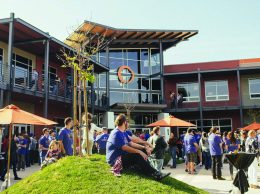Op/ed: The future is infinite at CES
By David Newton
Tech company taglines can seem overreaching or nebulous — even mundane. But my ninth year at the Consumer Electronics Show had me very aware of what top firms were saying about themselves just under their logos. The underlying message at this year’s show seemed to be “cut all cords” — or at least, keep cutting the cords, as ever-greater streaming speeds and bandwidth capacities allow for products and services to operate in millions of truly remote consumer settings.
The most impressive show-stopper was D-Link unveiling its new Ultra-WiFi router that promises to be the first device to break the 1 Gbps speed barrier. So while the current threshold is around 500 Mbps, consumers and businesses are now very close to considering 1.3 gigs per second to be the norm. Consider our dial-up modems, then DSL, of the 1990s running at kilobits per second, then giving way to the 1 megabit barrier, and the way 100 Mbps has now enabled a whole new era of live streaming products and services.
San Diego-based Qualcomm’s tagline confidently eggs on consumers with “Why Wait,” as if to say, there’s no reason to not be fully immersed in today’s super-fast tech products because really great stuff is here right now — and delivery speeds will no longer be an issue for functionality. Its Snapdragon processor will now power more than 1 billion Android phones worldwide, while its exhibit space was dominated by more than a dozen wearable products, including smart watches, digital eyewear, child-locators, cameras and personal fitness trackers.
On the other end, the Fujitsu logo’s “j” and “i” now incorporate the math-symbol for “infinity” to drive home its lofty tagline that ‘the possibilities are infinite’ — demonstrated in its 3-D cameras, ScanSnap’s secure cloud partnership with Citrix for personal scanners, compact but commercial-grade Celcius workstation, and futuristic Eclipse audio components. Once again, no cords and super-fast web speeds make these all happen.
In between those taglines, CES delivered Lenovo’s new Vibe Band smartwatch that monitors essentially every step you take during the day and your sleep through the night. It was also very cool to see Hisense position 3 curved OLED televisions end-to-end, creating a hyper-wide angle viewing experience for movies and games, as new software breaks up your source media into one-third panels to form a continuous, near “wrap-around” single-view image.
Perhaps lightning speed and no-cords are best epitomized by the buzz from Sling and its tagline to “Take Back TV,” with its very real threat to the cable company’s coaxial in your wall, offering live streaming television priced around $20/month — similar to Hulu, Netflix, TiVo, and Amazon Prime, picking up where disbanded Aereo didn’t quite get it right.
The fleet of three dozen BeamPro workplace remote-presence robots (from Palo Alto’s SuitableTech) was very impressive, allowing any manager or employee to show up for work and interact with people at any location worldwide through a five-foot-tall remote-drive robot with real-time voice and video presence. Remember when Santa Barbara entrepreneur Yulun Wang introduced InTouch remote robots into the healthcare industry? These true next-gen models are super agile, fast, reliable, easy-to-use, and a low-cost way to “be there” for any kind of office, warehouse, or sales call.
And finally, web speed makes the Spro2 from ZTE an incredible portable projector, not just due to its supper compact size and cool styling, but because in addition to no-cords projecting of your laptop/Mac presentations anywhere, it uses AT&T’s super broad LTE network to stream movies, TV, and games from any remote source or cloud.
The most impressive statistic was Qualcomm’s forecast that for 2014 to 2018, more than 8 billion smartphones will ship. Think of it. That’s more phones than there are people — 7.5 billion — on the planet.
• David Newton is a new venture consultant and teaches in the Center for Executive Development at The Rady School of Management at UC San Diego. His recent books include Crisis of Confidence (2012) and Job Creation: How It Really Works & Why Government Doesn’t Understand It (2010).










